| Columns Retired Columns & Blogs |
Why so "Heavy"? ........... Linkin Park :-) ..........
Because, in its flight case, each Moon by Simaudio 888 amplifier weighs 300 lb, I drove my Audio Precision SYS2722 system (see the January 2008 "As We See It"), with its host PC, monitor, test loads, and cables, to Mikey's place, rather than try to get one to my place and down the stairs from the front door to my basement test lab. We manhandled one 888 onto a dolly and wheeled it into Mikey's garage, where I set up my gear. Because the outlets in his garage weren't up to the amplifier's current demands, we ran a long, heavy-duty extension cord to one of the 20A outlets in his house.
Usually, before performing any measurements, I precondition an amplifier by running it for an hour at one-third its measured maximum power into 8 ohms—thermally, the worst case for an amplifier with a class-AB output stage. Time constraints—I needed to hit the road for the 45-mile drive home before the Friday-evening rush hour—meant that I had to cut the preconditioning period to 20 minutes. By the end of that time, the Moon 888's top panel was barely warm, at 78.4°F (25.8°C); the side-mounted heatsinks were hotter, at 109.6°F (43.1°C).
The voltage gain at 1kHz into 8 ohms using the balanced input was slightly higher than the specified 31dB, at 32dB. For the unbalanced input the gain was 29dB, 3dB lower than the balanced gain rather than the expected 6dB. The amplifier was non-inverting (ie, it preserved absolute polarity) with both inputs. Its balanced input impedance was 32k ohms at 20Hz and 1kHz, dropping to the specified 24k ohms at 20kHz. The unbalanced input impedance was 16k ohms at 20Hz and 1kHz, but 10k ohms at 20kHz.
The Moon 888's output impedance, including 6' of speaker cable, was very low, at 0.03 ohm at 20Hz and 1kHz, rising to 0.085 ohm at 20kHz. The modulation of the amplifier's frequency response, due to the Ohm's law interaction between this source impedance and the impedance of our standard simulated loudspeaker, was therefore minimal (fig.1, gray trace). Into an 8 ohm resistive load (fig.1, blue trace), the Simaudio's response was flat almost up to 20kHz, then rolled off to reach –3dB at 70kHz rather than the specified 200kHz. The response rolled off a little earlier into lower impedances.
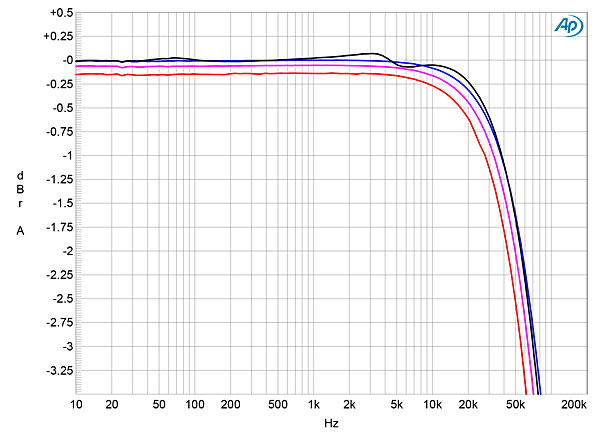
A rear-panel switch allows the amplifier to be operated with DC or AC input coupling. The DC response was flat down to 10Hz (fig.2, blue trace); the AC response began to roll off in the low bass, reaching –1dB around 15Hz (red trace). The amplifier's reproduction of a 10kHz squarewave into 8 ohms was commendably free from overshoot and ringing (fig.3).
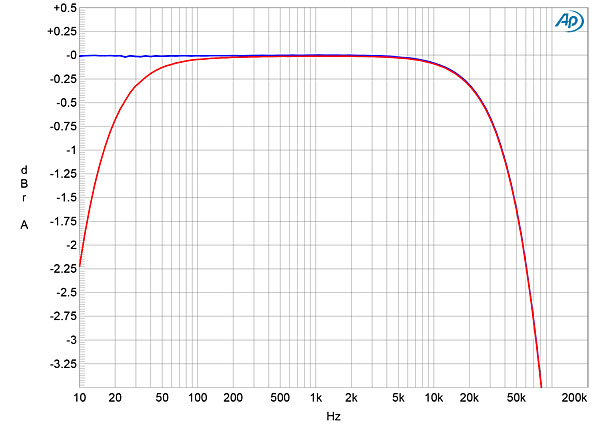
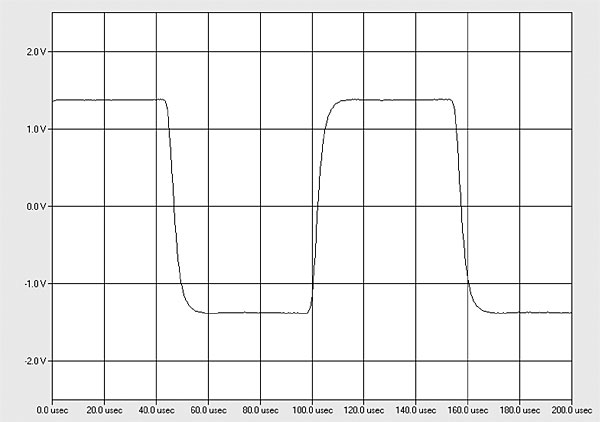
The Moon 888's unweighted, wideband signal/noise ratio, ref. 1W into 8 ohms and taken with the input shorted to ground, was 75.2dB. This improved to an excellent 87.3dB when the measurement bandwidth was restricted to the audioband, and to 89.8dB when the measurement was A-weighted. Spuriae were present in the amplifier's noise floor at the 60Hz power-supply frequency and its odd harmonic, but these all lay at or below –106dB ref. 1W into 8 ohms (0.0005%, fig.4).
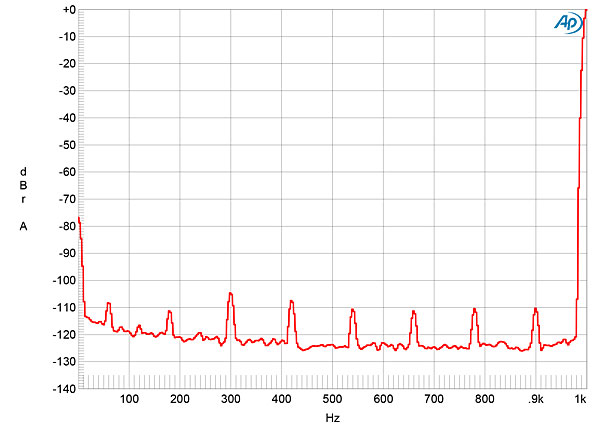
As its name suggests, the Moon 888 is specified as delivering a staggering 888W into 8 ohms (29.5dBW). Using our definition of clipping—ie, when the output's percentage of THD+noise reaches 1%—the amplifier exceeded that output, clipping with a 1kHz signal at 990W into 8 ohms (30dBW, fig.5). The clipping power didn't double when the load was halved, 1300W being delivered at clipping into 4 ohms (28.1dBW, fig.6), but it's fair to note that I didn't hold the wall voltage constant for this test. However, the Moon 888 turned itself off several times during these high-power tests, particularly when I tried (unsuccessfully) to measure the clipping power into 2 ohms.
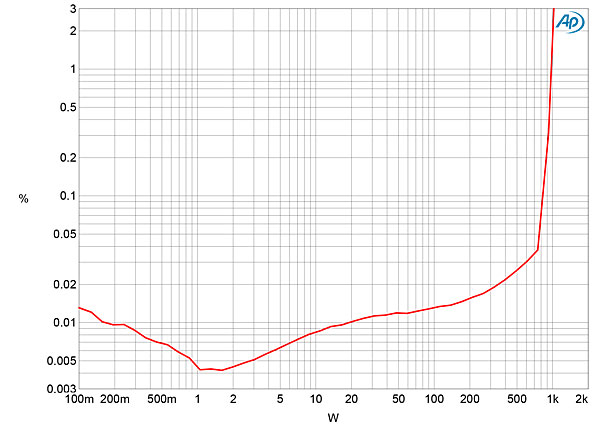
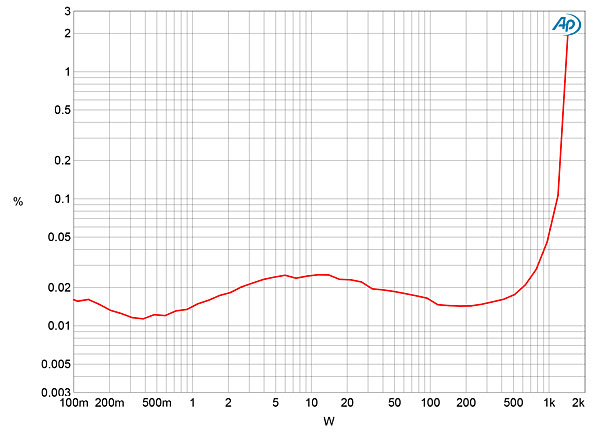
I examined how the percentage of THD+N changed with frequency at 20V, which is equivalent to 50W into 8 ohms, 100W into 4 ohms, and 200W into 2 ohms. The THD+N was extremely low in the midrange into 8 and 4 ohms (fig.7, blue and magenta traces), but rose into 2 ohms (red). In this test I sweep a tone from 20kHz down to 20Hz, and you can see that the 2 ohm trace cuts off at 80Hz, which was when the amplifier's protection kicked in (footnote 1). This behavior was reminiscent of what happened when I measured the Bricasti Design M15 amplifier, reviewed in the July issue. I also noticed that when I turned the Moon 888 off and on after one of these incidents, the percentage of THD+N was at first about twice as high as in fig.7; it then took about a minute to drop to the previously measured value.
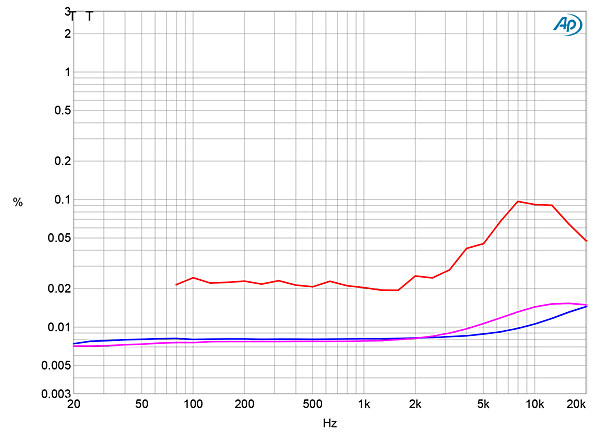
Fortunately, the Moon 888's distortion was predominantly the subjectively innocuous third harmonic (fig.8), and lay at a low –80dB (0.01%, fig.9), though the fifth and seventh harmonics rose to the level of the third harmonic at high powers into 4 ohms (not shown). Though some higher-order intermodulation products were evident when the amplifier drove an equal mix of 19 and 20kHz tones at high power into 4 ohms (fig.10), these all lay below –80dB, and the second-order difference product at 1kHz was vanishingly low in level, at –117dB (0.00014%).
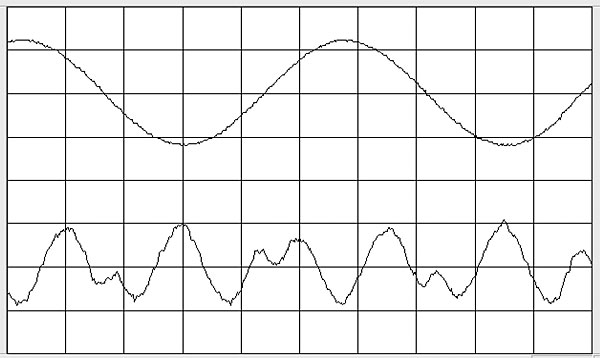
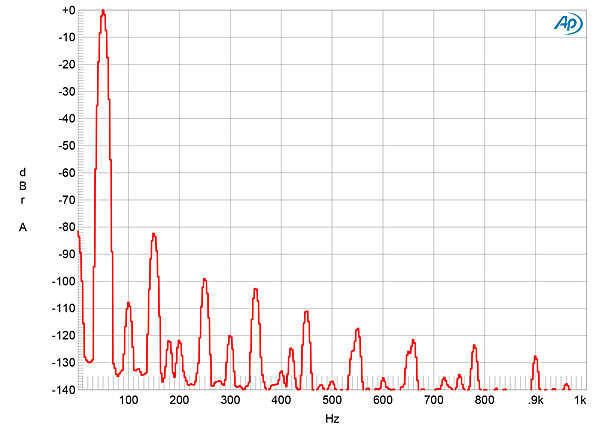
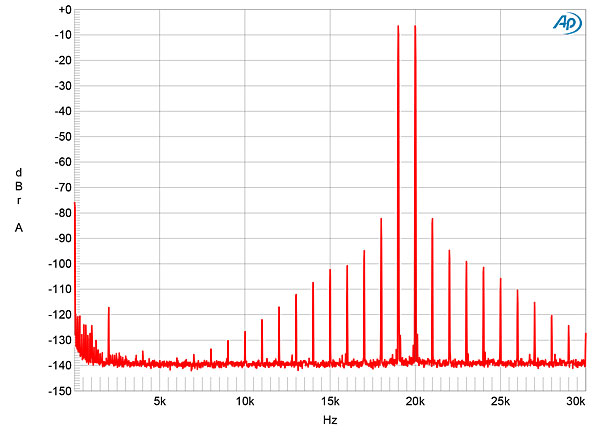
Overall, this is good measured performance. I suspect that the Moon by Simaudio 888's aggressive protection circuitry is due to the significant amount of energy that can be stored in an amplifier that can deliver more than a kilowatt into low impedances.—John Atkinson

Why so "Heavy"? ........... Linkin Park :-) ..........

... "could pump a couple of thousand watts into the Aida — a speaker that in my room needs, on average, probably less than 20W!"
Over on the Harbeth forum, Alan Shaw posted an example of a music piece that exhibited a dynamic range of about 22dB. In that case, even if your speakers required an average power of only 20W, you'd still need an amp capable of an output of about 3,200W to reproduce the instantaneous +22dB high peaks without clipping.
Does that mean you need an amp that can output 1, 2, or 3kW continuously and, as a result, costs $100K and weighs several hundred pounds? Not at all.
Simaudio should have the skunkworks engineers take a look at the old Hitachi class G amps and then design a new amp which can output maybe 100W-200W continuously and possibly 500W-1kW for some fraction of a second - and one that wouldn't need to cost a fortune and weigh a proverbial ton.

Sensitivity of Harbeth SHL5's are 86dB/1W/1m, 20W would produce a scary 99dB at 1m . Not sure how the journalist came to the figure of 20W. If you need 22dB headroom peaks off a base of 1W which is already very loud, you'll need an amp clean to 160W. Most decent amps rated 100W continuous should be able to meet this.


... live music - even when using unamplified acoustic instruments. The key is peak - not continuous.
Watch this video of a Harbeth Monitor 40 demo:
https://www.youtube.com/watch?v=bRMR9JZ1m0s
The peak power shown on the amplifier's display is close to 800W, which means that the peak output from the speakers is about 115dB SPL. No one in the room seems to be distressed by those sound levels.
The demo track being played is this one:
https://www.youtube.com/watch?v=XhuJxdaU87I

Yes and yes. And you're absolutely right.
Can Mr. Shaw's walking to the back of the room at position 5:08 on the video be taken as distress? How far from the speaker do you estimate he was finally standing and how many dB do you estimate that to be, as opposed to where he was standing initially?

... was too loud for Mr. Shaw, note that they were evaluating the first samples of the latest version of the Monitor 40 speaker. Perhaps he just wanted to determine how the speakers sounded from farther back in the room. In any event, no one there has their fingers in their ears or seems to be rushing to turn down the volume control.

'...no one there has their fingers in their ears or seems to be rushing to turn down the volume control.'
… which is a big credit to the speakers and the electronics. But how many people listen to music like this, hours on end, in a room this big, a distance from the speakers at what still could be 99 to 100dB? Yes it proves a point, thank you gentlemen, but in doing so lost some pragmatic credibility in my estimation. I’m surprised Mr. Shaw would actually post this video because I think it’s insincere, especially when he says Harbeths are nearfield monitors.
A Ferrari can flex its muscles in certain conditions e.g. on a racetrack. A Ferrari will also work on a normal road but it won’t be (and shouldn’t be) using its full capabilities when a Toyota Camry will do the job.

... from the CES in 2015, also with CH Precision amps.
As noted in the comments, there is one peak power reading of over 1700W and another of almost 1200W.
https://www.youtube.com/watch?v=UP8i8F62OlM

So, is 24 Bit recording and playback better than 16 Bits? :-) ...........

Google search says, maximum sound pressure levels of classical music played by an orchestra in a concert hall is 98 db :-) ...........

Unless we are recording 1812 cannons .......... Loudest cannon according to Google 120 db :-) ..........

Lets jog our memory on Newtons 2nd law. Can a domestic loudspeaker reproduce the sound of a cannon? or is what we hear on Kunzel's 1812 a scaled version for our living rooms?

Which begs the question ......... How many of us are willing, able and prepared for listening to the sound of firing cannons in our listening rooms? ........... Please raise your hands :-) ...........

...and before the five-oh starts showing up in our street.

1812 cannons?
Come on. I want accurate reproduction of that jet engine on "Back in the USSR" at 120 - 140 dB.
I wanna experience the sensation of a Sperm Whale echolocating right there in front on me. (Gotta be careful when you read that word, you know...;-D...) 174 dB.
We are audiophiles, we need to dedicate ourselves to accurate recreation of the live event!

According to Google ......... Blue Whales are the loudest on the planet, 188 db ........... Howler Monkey, a land animal is second loudest, 140 db .......... And yes, Blue Whales can sing :-) ..........

According to Google ........... Tiger Pistol Shrimp is the loudest 200 db ........ It lives under sea .......... Blue Whale 2nd loudest 188 db .......... Yes, blue whales can sing :-) ...........

These instruments can get loud ........... Trumpet 110 db, clarinet 114 db, trombone 115 db ...........

Transmission line speakers use somewhat similar principle for bass frequencies .........

Bose "wave guide" technology is somewhat similar ..............

According to Wikipedia, the "perceived" dynamic range of 16 bit audio can be 120 db or more with noise-shaped dither ............

http://www.speech.kth.se/prod/publications/files/qpsr/1982/1982_23_1_031-048.pdf

The report you are referring to is from 1982 ......... I don't know whether that matters or not .......... The information I got is from Google ......... I don't know whether that info is current or not ........ You can check Google if you are interested .........

Google search says, maximum sound pressure levels of classical music played by an orchestra in a concert hall is 98 db :-)
That's an average or RMS level, which is not relevant to amplifier clipping. What matters is the peak value. In the early 1980s I designed and built a true peak-reading SPL meter for an article published in Hi-Fi News magazine. IIRC, the highest peak I measured with that meter at a classical orchestral concert from a mid-hall seat was 108dB (unweighted).
John Atkinson
Editor, Stereophile

from that Alan Shaw video is a SPL meter (I have two in my iPhone) - why not show the viewer those 22dBs in action? I want to SEE that 115dB SPL. and a volt-amp meter accross the amplifier's output terminals!

... a speaker sensitivity of 86dB/1W/1m should result in a peak SPL of about 115dB (for each speaker).
CH Precision claim that their amp is equipped with a "DSP that monitors the instantaneous output voltage and current" and that "both values are sampled at around 100 kHz, ensuring peak values are properly detected." If you doubt the accuracy of the power readings, ask Cossy or Heeb for the specifics of their power monitoring circuit and display.
Regarding the sound level meter on your iPhone, you should verify the response time of the meter. Most inexpensive SPL meters have a relatively slow response time and won't be able to capture instantaneous peaks with a duration in the millisecond range. Also, the meter must have a peak hold function in order to allow you to read those peak levels. Typically, this sort of performance is only available from professional instruments, such as those from B&K.

Google search says, for a 86 db sensitive speaker we need 1024 watts to produce 116 db SPL ......... The same watts can produce 120 db SPL from a 90 db sensitive speaker .............

Someone still has to sit no more than 1 meter away from the speakers to appreciate each and every one of those decibels.

The Dutch gentlemen mentioned the amps are bridged. If the measurement is not compensating for this, we might be seeing twice the Watts being indicated on the meters.

I remember several years ago one of the audio reviewers did some welding with one of the class A amps from Mark Levinson ......... JA may know about this ........ Wonder whether these Sim Audio amps can do welding? :-) ..........

I think the audio reviewer was David Clark and the amps were ML No: 20 :-) ...........

Ok ...... Surprisingly this info is available on Google ........... I checked it after I posted the above comments ........... It is true ...... The reviewer was David Clark and the amps were ML No.20 .......... What is even more surprising is that those class A amps were only lukewarm to touch even after the welding ....... Google even has the picture of the welded steel on the website :-) ...........

"Footnote 1: I was using the Moon 888s when I measured the spatially averaged frequency responses of the EgglestonWorks Viginti speakers that Michael reviewed in June, and one of the amplifiers went into protection a couple of times then." An 800 watts amplifier going into protection several times while driving a pair of speakers??? Either the speakers - or the amplifiers - are not optimally engineered fro real life, or am I missing something?

"I was using the Moon 888s when I measured the spatially averaged frequency responses of the EgglestonWorks Viginti speakers that Michael reviewed in June, and one of the amplifiers went into protection a couple of times then."
I didn't have time to investigate further, I am afraid.
John Atkinson
Editor, Stereophile

Muscle amp :-) ......

I have seen so far only bits and pieces of this new eight-part series from HBO, but in every scene in which it appears that I have seen, the director and cinematographer have made the stereo system unusually intriguing, even when it appears in the background, out-of-focus:
http://www.vulture.com/article/sharp-objects-home-stereo-system.html

John Atkinson
Editor, Stereophile

It appears that the amps are not 888s ............. If they were, the whole cabinet would have come crashing down with 600 pounds of weight :-) ............

Simaudio thanks you for all the support they are getting on this forum :-) .............

They certainly are nice looking.

If Stereophile could get a review sample of the Naim Statement system, a review and comparison to the Moon 888 would be great!
I had the chance to hear the Naim Statement with Sonus Faber Aida's. That is an experience I will never forget!

Bryston has an amp 28-B mono-blocks, which can put out 1000 watts into 8 Ohms ......... Stereophile has reviewed them :-) .............

May be PS audio could make 1000 watt class-D mono-blocks? :-) .............

@JA
Question about this statement which I see on occasion for various Amp measurement tests:
"but it's fair to note that I didn't hold the wall voltage constant for this test"
How does one go about holding the wall voltage constant in a domestic living environment?
Thanks

How does one go about holding the wall voltage constant in a domestic living environment?
Short answer: you can't, hence my measurements reflect an amplifier's output power under real-world conditions.
Longer answer: with an amplifier with unregulated power supply (almost all of them), if the wall voltage drops as the amplifier's demand for current increases, it will clip at a lower power than if the wall voltage was held constant. Manufacturers therefore specify the maximum power with a constant wall voltage.
John Atkinson
Editor, Stereophile

... variac or a power conditioner enable manual or automatic compensation for changes in AC line voltage?
https://www.variac.com/staco_3PN10_20.htm
https://www.tripplite.com/2400w-120v-power-conditioner-automatic-voltage-regulation-avr-ac-surge-protection-6-outlets~LC2400

Both Variac and Tripp-lite have several negative reviews on Amazon ........ Like, smoke coming out, plastic burning etc. ..............

Wouldn't either a variac or a power conditioner enable manual or automatic compensation for changes in AC line voltage?
It would, though a Variac large enough to maintain a constant AC voltage with this Moon amplifier would be enormous. I do have a smaller Variac, but I decided years ago that our measurements of output power would reflect what our readers would experience, not what an amplifier would deliver under perfect conditions.
John Atkinson
Editor, Stereophile

I suppose the best advice in ts review would be taken from the author himself:
" ...Don't ever forget: Any equipment review is built only on the shaky foundation of the review sample's interactions with the system's other components."
pj